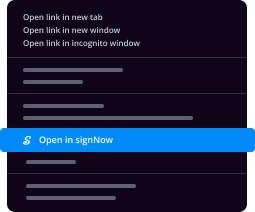Sign Pennsylvania Banking RFP Fast
Make the most out of your eSignature workflows with airSlate SignNow
Extensive suite of eSignature tools
Robust integration and API capabilities
Advanced security and compliance
Various collaboration tools
Enjoyable and stress-free signing experience
Extensive support
Keep your eSignature workflows on track
Our user reviews speak for themselves






Rapidly Approve Pennsylvania Banking RFP
When you require to authorize Pennsylvania banking RFPs promptly and effectively, airSlate SignNow is a superb option. This intuitive platform provides transformative advantages for enterprises aiming to optimize their document approval workflows. With its powerful features and clear pricing structure, airSlate SignNow allows you to handle all your eSignatures effortlessly while guaranteeing compliance and security.
Steps to Quickly Approve Pennsylvania Banking RFP with airSlate SignNow
- Launch your web browser and go to the airSlate SignNow site.
- Establish a complimentary account or sign into your current one.
- Upload the file you intend to authorize or send for eSignature.
- If you aim to utilize this file later, transform it into a reusable template.
- Choose your document and make necessary modifications by adding fillable fields or inserting needed information.
- Authorize the document and include signature fields for the recipients.
- Hit 'Continue' to complete and send your eSignature invitation.
In summary, airSlate SignNow enables organizations to effectively send and authorize documents while offering a comprehensive feature set that assures a signNow return on investment. Its user-friendly interface is specifically crafted for small to mid-sized enterprises, rendering it a versatile solution for diverse requirements.
Eager to enhance your document approval process? Begin your journey with airSlate SignNow today and enjoy seamless eSigning for your Pennsylvania banking RFP!
How it works
Rate your experience
-
Best ROI. Our customers achieve an average 7x ROI within the first six months.
-
Scales with your use cases. From SMBs to mid-market, airSlate SignNow delivers results for businesses of all sizes.
-
Intuitive UI and API. Sign and send documents from your apps in minutes.
A smarter way to work: —how to industry sign banking integrate
FAQs
-
What is airSlate SignNow and how can it help me sign Pennsylvania Banking RFP fast?
airSlate SignNow is an electronic signature platform designed to streamline the document signing process. With its user-friendly interface, you can quickly and securely sign Pennsylvania Banking RFP fast, reducing the time it takes to finalize important agreements.
-
How much does it cost to use airSlate SignNow for signing Pennsylvania Banking RFPs?
airSlate SignNow offers various pricing plans to fit different business needs. Whether you're a freelancer or a large organization, you can choose a plan that allows you to sign Pennsylvania Banking RFP fast without breaking the bank.
-
What features does airSlate SignNow offer for signing Pennsylvania Banking RFPs?
airSlate SignNow includes features like customizable templates, advanced security options, and real-time tracking. These tools ensure that you can sign Pennsylvania Banking RFP fast and efficiently, while maintaining compliance and security.
-
Is it easy to integrate airSlate SignNow with other tools for signing Pennsylvania Banking RFPs?
Yes, airSlate SignNow seamlessly integrates with various applications like Google Drive, Salesforce, and Dropbox. This allows you to manage documents and sign Pennsylvania Banking RFP fast without switching between multiple platforms.
-
Can I use airSlate SignNow on mobile devices to sign Pennsylvania Banking RFPs?
Absolutely! airSlate SignNow offers a mobile app that allows you to sign Pennsylvania Banking RFP fast from anywhere, at any time. This flexibility is perfect for busy professionals on the go.
-
What security measures does airSlate SignNow implement for signing Pennsylvania Banking RFPs?
airSlate SignNow prioritizes security with features like encryption, two-factor authentication, and audit trails. You can trust that your documents are safe while you sign Pennsylvania Banking RFP fast.
-
Are there any limits on the number of documents I can sign using airSlate SignNow?
Depending on your chosen plan, there may be limits on the number of documents you can sign. However, airSlate SignNow allows you to sign Pennsylvania Banking RFP fast without worrying about excessive fees for additional documents.
Trusted esignature solution— what our customers are saying
Get legally-binding signatures now!
Related searches to Sign Pennsylvania Banking RFP Fast
Frequently asked questions
How do you make a document that has an electronic signature?
How to sign pdf electronically?
How do i digitally sign a pdf with a timestamp?
Get more for Sign Pennsylvania Banking RFP Fast
- How Do I Implement Electronic signature in G Suite
- How Can I Implement Electronic signature in G Suite
- Can I Implement Electronic signature in G Suite
- How To Set Up Electronic signature in Word
- How Do I Set Up Electronic signature in Word
- How To Implement Electronic signature in Word
- How Do I Implement Electronic signature in Word
- How Can I Implement Electronic signature in Oracle
Find out other Sign Pennsylvania Banking RFP Fast
- Sumter county quick claim deed form
- Affidavit form letter for drilleramp39s restricted license deq state ms
- City of cuyohaga falls income tax form
- Present tense simple or progressive form
- Montefiore mychart form
- Application for license to operate a private accs form
- Tandem jump medical form skydive strathallan
- Rd1061 form
- Inz 1190 form
- Spruce lane evergreens form
- Lecture ii micro data a helicopter tour new york university econ nyu form
- How to file vsp claim messa messa form
- Ipid complaint form
- Madaptap form
- Roper hospital jobs form
- Certificate of medical education l2 the medical board of california mbc ca form
- Wi 1a online fillable tax form
- Eenadu cricket cup e form
- Form 2039 summons department of justice justice
- Application for diplomatic official visa to indonesia 100422166 form






































